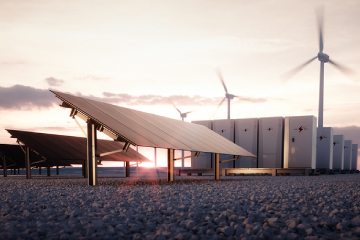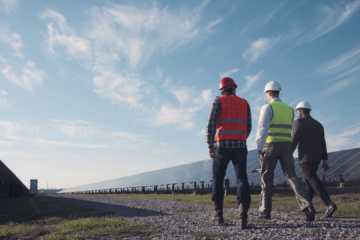- Why EDF power solutions?
- About UsAbout UsWe’re committed to providing future generations with the means to power their lives in the most economic, environmental and socially responsible ways possible.
- What We DoWhat We DoWe are a market-leading, independent power producer and service provider, delivering: wind (onshore and offshore), solar photovoltaic, storage, and electrical vehicle charging.
- Landowners
- Suppliers
- Projects
- Careers
- News
- Contact
Blade Disposal: Our Commitment to Sustainability

By Patrick Richardson, Manager, Wind Technology Optimization
The United States has set goals for decarbonizing the nation’s electricity sector by 2035 and making the economy carbon-neutral by 2050. Thanks in large part to major investments in clean energy driven by the 2022 Inflation Reduction Act, the country is making significant progress toward these targets.
Wind energy has a vital role to play, with 70,000 wind turbines totaling 146 gigawatts of capacity in operation today – enough to power 46 million American homes with clean, reliable electricity. And US wind capacity is expected to grow significantly over the next 10-15 years.
This is a great boon to the cause of reducing carbon emissions but is accompanied by the unavoidable fact that every wind turbine that goes up must, eventually, come down. As we navigate society’s transition to clean energy, we must develop and implement strategies to sustainably manage equipment that reaches the end of its life.
Most wind farms are designed to have operational lives of 30 to 40 years. However, due to significant technological improvements over the past 15 years, some existing projects are in the process of repowering – replacing older equipment with more modern and efficient technology that can produce more power. Repowering makes economic sense – less turbines, more energy generated.
Repowering often involves replacing all turbine components save the tower and its concrete foundation, though in some cases entire turbines and even parts of the wind farm’s balance of plant may be decommissioned. The good news is that it’s relatively easy to reclaim more than 90% of a turbine’s mass for other uses. The towers, which are 100% steel, can be recycled, yielding new steel with a significantly reduced carbon footprint. In addition, much of the remaining equipment, including cabling, power electronics, hub, and frame, contain large amounts of reclaimable materials. Lastly, mechanical components such as gearboxes and generators can be returned to equipment manufacturers to be rebuilt and reused.
Although repowering boosts the amount of carbon-free electricity delivered to the grid, it also results in many blades that are no longer needed – and these are more challenging to deal with than the metallic components of turbines. While blades can be recycled, the fact that they are constructed from a mix of materials – fiberglass, carbon fiber, and balsa wood – increases the technological complexity of doing so.
In the past, many decommissioned blades ended up in landfills. According to the US Department of Energy, the current average rate of blade retirements is in the range of 3,000-9,000 annually, a figure that is expected to rise to 10,000-20,000 blades per year by 2040; the sustainability of landfilling will decrease as the blade disposal volumes increase.
Our Commitment
While blades are chemically inert and present no threat to ecosystems or the environment, at EDF Renewables we recognize that landfilling disused blades is not a sustainable solution. For this reason, in 2023, we made the following global commitments:
- EDF Renewables commits to either reuse, recycle, or recover the decommissioned wind turbine blades for projects where we maintain a full or partial ownership stake and operational decision-making authority.
In addition, we will continue our industry-leading blade inspection and repair services, which reduce the need for blade replacement by extending and maximizing the useful life of each blade.
In keeping with this commitment, EDF Renewables North America is playing a leading role in industry discussions about ways to expand blade recycling infrastructure in the US. These efforts will benefit from advanced manufacturing tax credits provided in the Inflation Reduction Act that are designed to stimulate the growth of domestic recycling. In addition to supporting original research through partnerships with institutions in the US and Europe, we are also helping to shape industry standards and leading by example.
Alternatives to Disposal
While opportunities to divert blades from landfills in the US are still limited, the range of options is growing. At the top of the list is prevention, which refers to designing blades that are easy to recycle, and at least two global manufacturers have announced fully recyclable blades. Reuse refers to installing used blades from decommissioned turbines on similar turbines that are still operational. However, the potential for this is limited, as most turbines with compatible blades are of a common vintage, and their decommissioning would likely occur just a few years apart.
Repurposing blades for new and different applications – from outdoor art installations to public infrastructure, and even furniture and home or office décor – can produce creative results, but this method’s potential for disposal of large volumes is limited by demand for the end products.
That leaves recycling and recovery, the two approaches with the highest potential for widespread implementation in the next several years. Recycling can be accomplished through chemical, thermal, or mechanical processes; recovery means converting the energy in waste material into heat.
Although research is ongoing to further improve chemical and thermal processes for recycling blades, mechanical recycling – which involves grinding or crushing the blades to produce a uniform product – is the most practical and cost-effective option available. Blades can be ground, and the resulting chopped glass fibers included in concrete mixes, increasing their mechanical strength. Blades can also be shredded and used to manufacture durable products such as furniture, playground equipment, or fencing.
Disposal Options
Cement co-processing is a disposal method that recovers 30% of the blade’s mass by incineration in a cement kiln and recycles 60% of the mass by using the byproducts of combustion as ash and sand in the cement created in that very kiln, leaving only 10% of the blade’s mass as waste. Waste-to-energy (WTE) recovers the entire blade, processing the blades in municipal trash incinerators to produce electricity.
Charting a Course for Sustainability
As a company focused on creating a better world by generating clean energy, EDF Renewables strives to take all our impacts on the environment into account.
EDF Group is leveraging its internal resources to support and participate in research – both in the US and Europe – to advance scientific knowledge regarding recycling methods and uses for the byproducts of recycled materials from renewable energy projects.
We look forward to doing our part to advance these exciting new technologies and contribute to the sustainability of our industry as we work to make the clean energy transition a reality.
Post a Comment Cancel reply
- © 2025 EDF power solutions North America North America
- Privacy Policy
- AB 1305 Disclosure
- TCFD Report
- EDF power solutions




Comments (1)
Can this blade be customized for specific industrial needs?
13l stainless steel axial flow blade Norristown